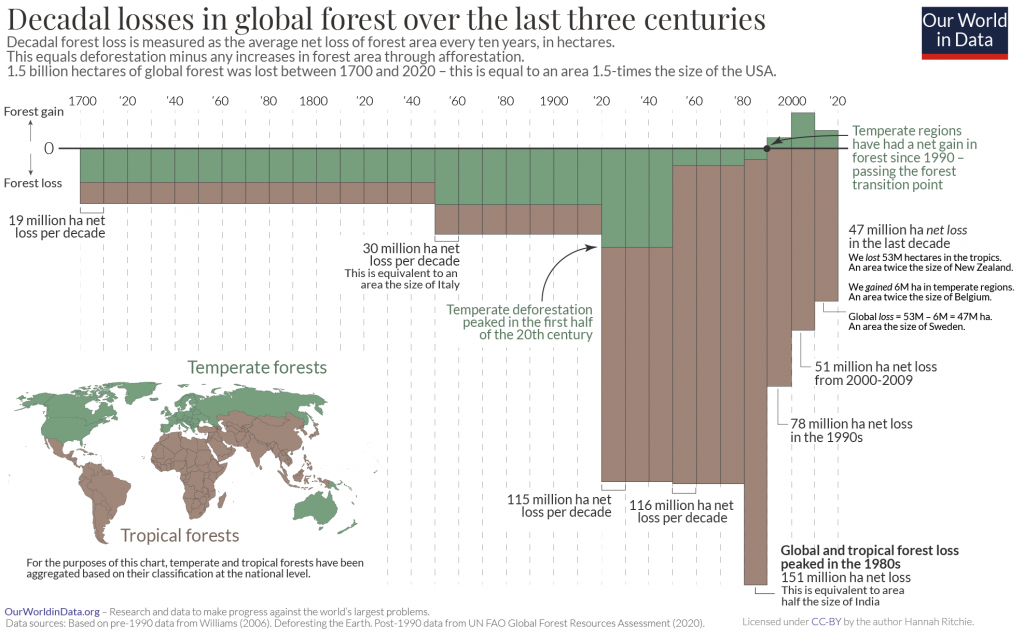How Sustainable Is Black Cherry Wood? Here Are the Facts
Impactful Ninja is reader-supported. When you buy through links on our site, we may earn an affiliate commission.
Learn more
Learn more
.
Hey fellow impactful ninja ? You may have noticed that Impactful Ninja is all about providing helpful information to make a positive impact on the world and society. And that we love to link back to where we found all the information for each of our posts. Most of these links are informational-based for you to check out their primary sources with one click. But some of these links are so-called "affiliate links" to products that we recommend. First and foremost, because we believe that they add value to you. For example, when we wrote a post about the environmental impact of long showers, we came across an EPA recommendation to use WaterSense showerheads. So we linked to where you can find them. Or, for many of our posts, we also link to our favorite books on that topic so that you can get a much more holistic overview than one single blog post could provide. And when there is an affiliate program for these products, we sign up for it. For example, as Amazon Associates, we earn from qualifying purchases. First, and most importantly, we still only recommend products that we believe add value for you. When you buy something through one of our affiliate links, we may earn a small commission - but at no additional costs to you. And when you buy something through a link that is not an affiliate link, we won’t receive any commission but we’ll still be happy to have helped you. When we find products that we believe add value to you and the seller has an affiliate program, we sign up for it. When you buy something through one of our affiliate links, we may earn a small commission (at no extra costs to you). And at this point in time, all money is reinvested in sharing the most helpful content with you. This includes all operating costs for running this site and the content creation itself. You may have noticed by the way Impactful Ninja is operated that money is not the driving factor behind it. It is a passion project of mine and I love to share helpful information with you to make a positive impact on the world and society. However, it's a project in that I invest a lot of time and also quite some money. Eventually, my dream is to one day turn this passion project into my full-time job and provide even more helpful information. But that's still a long time to go. Stay impactful,Affiliate Disclosure
Why do we add these product links?
What do these affiliate links mean for you?
What do these affiliate links mean for us?
What does this mean for me personally?
![]()
Black cherry wood is an excellent choice for furniture and musical instrument projects because of its durability, strength, and reddish-brown color, which becomes deep and rich with age. However, as the black cherry trees support many animals, birds, and insects, cutting down the trees hurts wildlife. So we had to ask: How sustainable is it to buy products made out of black cherry wood?
Black cherry wood is sustainable because black cherry trees capture carbon from the atmosphere, while black cherry furniture works as long-lasting carbon storage. Burning wood waste also creates energy, substituting fossil fuel. Because of its abundance, it is possible to harvest the wood without harming the forests.
In this article, we’ll walk you through the life-cycle of black cherry wood used for furniture and musical instruments. Then, we evaluate its sustainability, potentials, and shortfalls. And in the end, we’ll show you tips for buying sustainable black cherry wood.
Here’s How Sustainable Black Cherry Wood Is
Black cherry wood is a sustainable material because of the carbon sequestration of the living black cherry trees and the carbon offset value at the end of any products made with back cherry wood.
“Sustainable: The ability to be maintained at a certain rate or level | Avoidance of the depletion of natural resources in order to maintain an ecological balance”
Oxford Dictionary
To better understand the sustainability of black cherry wood, we assess the life-cycle of projects like flooring or furniture. This life-cycle assessment (LCA) is a method to evaluate the environmental impacts of each stage in a product’s life-cycle, from the making to the recycling. Over the years, companies have strategically used LCA to research and create more sustainable products.
In this article, we’ll use the cradle-to-grave perspective of the LCA, examining the five stages of the life cycle of black cherry wood. Where it is relevant, we also use data from cradle-to-gate assessments.
| The life-cycle stages of black cherry wood | Each stage’s sustainability |
| Growing of black cherry wood | Growing black cherry trees for timber is sustainable thanks to the carbon sequestration potential and the fast-replacement rate. |
| Manufacturing of black cherry wood | Turning black cherry wood into furniture has a relatively low carbon footprint because wood waste can be recycled fully as by-products or biomass pellets to offset the carbon emissions during harvesting and processing. |
| Transporting of black cherry wood | Transporting is a relatively carbon-intensive stage in the life cycle of black cherry furniture due to the emissions associated with operating the hauling vehicles that take timber to sawmills and factories, then furniture to stores. As black cherry trees grow in the US, a piece of black cherry furniture would have a lower carbon footprint than that made from imported woods. |
| Usage of black cherry wood | Using black cherry furniture can be sustainable thanks to the carbon capture during the products’ long life. |
| End-of-life of black cherry wood | The end-of-life stage for black cherry furniture is sustainable when the wood is reused or burned as bioenergy. |
Overall, we can say that black cherry wood is sustainable. However, the actual environmental impact of a particular product, like a table or a cabinet, depends on many factors, especially the distance and mode of transportation. Let’s dive deeper into each stage and find out how it can be more sustainable.
How Sustainable Is the Growing Black Cherry Wood
Growing black cherry trees for timber is sustainable thanks to the carbon sequestration potential and the fast-replacement rate.
What Type of Wood is Black Cherry and What Does This Mean for Sustainability
Black cherry wood comes from a fast-growing hardwood tree of the species Prunus serotina. These North-American-native trees are also known as wild cherry or American cherry.
The average growth rate of black cherry trees is 2-4 feet a year. That is two to four times faster than the average growth rate of, for example, white oak trees. Growth is rapid up to 50 years and then slows as the tree reaches maturity.
How Sustainable Does Black Cherry Wood Grow
Black cherry’s sustainability lies in the potential for carbon sequestration and the fast replacement rate.
- Carbon Sequestration: As black cherry trees grow, they absorb CO2 from the atmosphere while releasing oxygen. They act as a carbon sink during their long lifespan, which has been recorded as long as 258 years. This means that they are taking greenhouse gases out of the atmosphere, helping to mitigate the climate crisis. And they can store a lot as they grow up to 100 feet in height and 5 feet in trunk diameter.
- Fast replacement rate: Two factors contributing to black cherry’s replacement rate are the sufficient growing stock and rapid growth. On the best sites, black cherry can reach 80 to 100 feet in 60 years. Currently, it takes 6.12 seconds for the US forests to replace 1 cubic meter of black cherry. Black cherry’s replacement rate is three times faster than that of ash and twice faster than that of walnut. It indicates that cherry wood is more available and more sustainable than hardwood species like black walnut or ash.
Where Is Black Cherry Wood Usually Grown
Black cherry trees grow throughout the eastern and central United States, but they grow best in the conditions of the Allegheny Plateau Pennsylvania, New York, and West Virginia.
Black cherry trees are part of many forest covers, from dry semi-arid deserts to subtropical climates, mixing with other trees like hemp, pine, or oak. Black cherry trees are also used to rehabilitate land that was spoiled by coal mines. Year-old seedlings are planted to reclaim old surface mines and re-establish viable forest communities.
Harvesting meranti wood from natural forests can result in biodiversity loss regarding the tree species and wild animals that feed and shelter in the forests.
One example is when loggers only cut down the biggest and tallest trees. That pattern would cause a reduction in the genetic diversity and quality of the trees within the stand, leading to gradual degradation of tree quality.
Cutting down black cherry trees also disrupts the forests’ wild animals, which depend on the forest for food and shelter. These flowering trees provide nectar for pollinators and host larvae of several butterfly species. Fruits are eaten by many songbirds, including robin, brown thrasher, mockingbird, starling, blue jay, sparrows, woodpeckers, flycatcher, and thrushes. Black cherry fruits are also important summer-through-fall diets of mammals like white-tailed deer, red fox, raccoon, squirrels, and rabbits.
Illegal logging of black cherry in the US is unfortunately not non-existent. Black cherry is amongst the sought-after wood by poachers because it is prized for fine furniture and musical instruments.
The only way for consumers to tackle problems caused by illegal logging is to source sustainable woods. We will point you in the right direction with black cherry wood at the end of this article.
In total, logging of forestry products from plantations accounts for 26% of forest loss, which is a combination of deforestation and forest degradation. However, the loss in bio-diverse forests in tropical climates is more significant (and sometimes less properly recorded) than in temperate, well-managed logging forests.

How Sustainable Is the Manufacturing of Black Cherry Wood
Turning black cherry wood into furniture has a relatively low carbon footprint because wood waste can be recycled fully as by-products or biomass pellets to offset the carbon emissions during harvesting and processing.
The first step of manufacturing black cherry furniture involves cutting down trees and turning them into lumber in a sawmill. The carbon emissions here come from electricity usage. It is easy to cut and saw black cherry logs because the wood is relatively soft and not too dense, less so than some other hardwood like oak or ash.
The next step is to dry lumber before turning it into furniture. If a piece of lumber can be air-dried to the desired moisture content, no added energy is needed for this step. However, if a kiln is used, it requires extra energy, which could mean higher carbon emissions.
It is relatively simple to dry black cherry timber. Different kiln schedules can take from 94 to 120 hours to dry one cubic meter of 4/4 inch black cherry logs. The carbon footprint of the drying step for a 4/4 inch log is 42.7 kg CO2-eq, according to a life cycle assessment tool of the American Hardwood Export Council.
A high proportion of energy can come from burning wood waste. At least 90% of all thermal energy used for kiln drying in the US hardwood sector is derived from biomass.
How Sustainable Is the Transportation of Black Cherry Wood
Transporting is a relatively carbon-intensive stage in the life cycle of black cherry furniture due to the emissions associated with operating the hauling vehicles that take timber to sawmills and factories, then furniture to stores.
As black cherry trees grow in the US, a piece of black cherry furniture would have a lower carbon footprint than that made from imported woods like mahogany, providing they are both sold in the US.
The actual emission during this stage depends on the type of vehicles used, the fuel they need, and the distance the wood travels. A calculation from PE International AG shows that transporting activities, including from forest to kiln and from kiln to customer, have roughly the same carbon footprint as the combination of forestry, sawmill, and drying activities. In other words, transportation accounts for half of the carbon footprint of cherry wood production in a cradle-to-gate assessment.
Calculations made by the Norwegian Forest and Landscape Institute showed that smaller wood hauling trucks emitted more CO2 per transported cubic meters of timber: 1.25 times more than larger wood hauling trucks, 1.3 times more than sea vessels, and six times more than freight trains. Therefore, the sustainable transportation option would be rail or large trucks running on biofuel. You can check with your wood suppliers how their products are transported and opt for the more sustainable option.
In comparison with some other American hardwoods, the growing, manufacturing, and transporting of black cherry wood have a relatively lower carbon footprint. When PE International AG assessed the environmental impacts of 19 American hardwoods through stages from cradle to gate plus transport, they found a carbon footprint of 301 kg CO2-eq for one cubic meter of kiln-dried black cherry logs. That is lower than the carbon footprint of most other hardwoods in the study, including hard maple (394 kg CO2), ash (407 kg CO2), and white oak (559 kg CO2).
How Sustainable Is the Usage of Black Cherry Wood
Using black cherry furniture can be sustainable thanks to the carbon capture during the products’ long life.
Black cherry is a durable hardwood, suitable for a wide range of household projects from furniture to flooring to doors. Resistant to decay and weather changes, black cherry wood is considered more durable than maple. It is a sustainable local alternative to mahogany. When properly taken care of, it can last from fifteen up to twenty-five years.
When black cherry wood is decayed, either naturally in the forest or because of damage caused by usage at home, the carbon stored in the wood is released back to the atmosphere. Therefore, long-lasting furniture can be considered a good way of keeping carbon out of the atmosphere. If the wood is then reclaimed for making another piece of furniture, its positive carbon storage environmental impact is even higher.
How Sustainable Is the End-of-Life of Black Cherry Wood
The end-of-life stage for black cherry furniture is sustainable when the wood is reused or burned as bioenergy.
There are a few scenarios for wood products – furniture, flooring, and musical instruments- at the end of their life.
They can end up in landfills and don’t decompose. In this case, it keeps its role as carbon storage.
Wood products can also be upcycled and reused, extending their role as carbon storage and reducing the fossil CO2 emitted as much as four times when comparing, for example, a recovered hardwood flooring with a new one. New wood products often travel much further to their markets, compared with recovered wood products. The latter is typically made in urban centers and sold locally, which lowers the transportation environmental burdens.
In another end-of-life scenario, products like a black cherry bed can be burned for biomass energy displacing coal or natural gas in generating electricity.
With smaller household items, like a doorknob or a small chair, the offset won’t be as high as there is much less waste for burning. However, if such products are made from manufacturing wood waste as by-products, their carbon footprint is minimal.
How Can You Buy Black Cherry Wood More Sustainably
The key to sustainably buying any wood is to check on relevant environmental and original certifications. Reliable certifications for sustainable woods are:
An FSC certification ensures that the black cherry wood comes from responsibly managed forests that provide environmental, social, and economic benefits.
PEFC’s approaches to sustainable forest management are in line with protecting the forests globally and locally and making the certificate work for everyone. Getting a PEFC certification is strict enough to ensure the sustainable management of a forest is socially just, ecologically sound, and economically viable but attainable not only by big but small forest owners.
Why Is It Important to Buy More Sustainable Wood
Buying sustainable wood also means helping to prevent illegal or unsustainable logging, which harms the forests’ biosystems and accelerates climate change.
Logging of forestry products from plantations accounts for 26% of forest loss. Cutting down trees for wood has a lesser impact on carbon storage than digging up the whole forest floor and turning it into farms or mines. However, if logging is not sustainably managed, it can badly damage wildlife.
When logging happens in tropical forests – the bio hotspots of our planet – the biodiversity loss can be much more damaging. Subtropical and tropical forests are packed with unique wildlife – endemic mammals, birds, and amphibians. The displacement of such wildlife during poorly managed logging would be a major contributor to global biodiversity loss.
Sustainable management of forests also means that trees are cut down for timber only when they are mature. These trees will then be able to regrow and eventually replace the loss of canopy, absorb carbon from the atmosphere and reduce the effect of climate change.

Final Thoughts
You can buy sustainable furniture made from black cherry wood as long as the material comes from sustainably managed forests. And, to make it even more sustainable, use any black cherry furniture for as long as you can, upcycle the material to extend its usage, and arrange for it to be recycled fully.
Stay impactful,

Sources
- Science Direct: Life-cycle assessment (LCA)
- MIT SMR: Strategic Sustainability Uses of Life-Cycle Analysis
- European Environment Agency: cradle-to-grave
- Science Direct: Cradle-to-Gate Assessment
- Wildflower: Prunus serotina
- Kansa Forest Service: Black Cherry
- Impactful Ninja: How Sustainable Is White Oak Wood? Here Are the Facts
- WAGNER METERS: Working with Cherry Wood
- THE WOOD DATABASE: BLACK CHERRY
- University of Idaho College of Natural Resources: Black cherry
- American Export Hardwood Council: American Hardwood’s Life Cycle Assessment Tool
- Impactful Ninja: How Sustainable Is Black Walnut Wood? Here Are the Facts
- Impactful Ninja: How Sustainable Is Ash Wood? Here Are the Facts
- Impactful Ninja: How Sustainable Is Pine Wood? Here Are the Facts
- North Carolina EXTENSION: Prunus serotina
- US Forest Service: Prunus serotina
- Freethink: The fight to end illegal logging
- Our World in Data: Deforestation and Forest Loss
- US Forest Service: A comparison of kiln-drying schedules and quality outcomes for 4/4-thickness black cherry lumber sawn from small-diameter logs
- American Hardwood: Environmental Life Cycle Assessment
- Impactful Ninja: How Sustainable Is Mahogany Wood? Here Are the Facts
- PE INTERNATIONAL AG: Life Cycle Assessment of Rough-sawn Kiln-dried Hardwood Lumber
- Science Norway: Larger logging trucks give less CO2 emissions
- Impactful Ninja: How Sustainable Is Maple Wood? Here Are the Facts
- Impactful Ninja: How Sustainable Is Ash Wood? Here Are the Facts
- FURNISHING TIPS: Cherry vs. Maple Furniture
- Research Gate: Life cycle primary energy and carbon analysis of recovering softwood
- Forest Stewardship Council
- Program for Endorsement of Forest Certification
- Our World in Data: Epidemic Mammal Species




